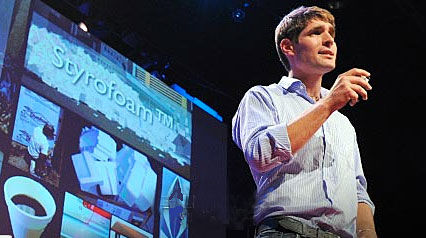Expanded polystyrene foam, the petroleum-based material most Americans call Styrofoam, is nasty stuff. It’s made from finite resources — a single cubic foot of Styrofoam equals the energy content as 1.5 liters of gasoline — yet hangs around practically infinitely: The EPA estimates it occupies 25 percent of our landfills by volume. Product designer Eben Bayer hates this carcinogenic, “toxic white stuff.” And he’s spent the last three years working on an awesome-sounding replacement for it, made from mushrooms and crop waste.
In the TED talk below, Bayer explains how his company, Ecovative Design, has designed a process called Mycobond that can produce low-energy, fully compostable packaging (and insulation) using a local manufacturing model. Here’s how it works: first you find a local available waste feedstock, say cotton hulls in the South or corn stalks in the Midwest; put it in a product mold; inoculate the mold with a fungus whose root structure — “mycelium” — quickly grow around and digest the material, self-assembling the product, for example a corner block for shipping furniture, in about five days. This seems light years ahead of other compostable packaging, which as Ask Umbra tells us is mostly made from genetically engineered corn — itself a petroleum-hungry crop — and manufactured in energy-guzzling plants.
Even better, when the mushroom packaging’s purpose is done, it can go straight back into Nature’s perfect recycling system: the soil.
“This recycling system has been in place for the last billion years. I fit into it, you fit into it, and a hundred years tops, my body can return to the Earth with no preprocessing. Yet that packaging I got in the mail yesterday is going to last for thousands of years. This is crazy,” says Bayer.
So crazy. When can we get off this bad trip? Check it out:


